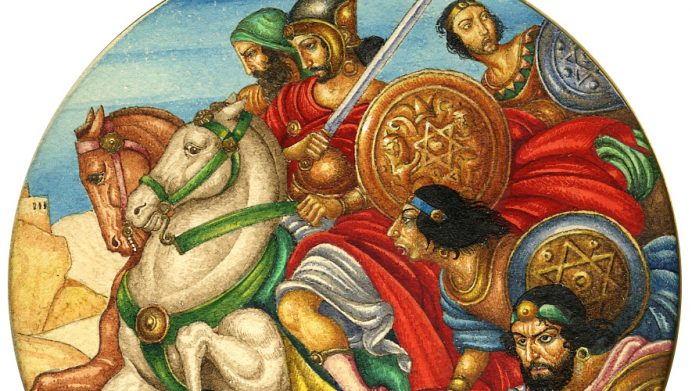Calev Ben-Dor argues that the fight raging today between Israeli politicians about how to interpret the meaning of ancient Jewish texts reflects the political chasm currently separating the two national-religious parties. ‘One focuses on the dangers of zealotry, the other on the importance of principles come what may,’ he writes. Some Zionists have long heroised Bar Kochba, the leader of the doomed Jewish revolt of 132-135 CE against the Romans, while in recent decades others have warned of the suicidal consequences of contracting ‘Bar Kochba Syndrome’.
The debate started, as it increasingly seems to do these days, on twitter.
But first, some notes of context: 27 June to 18 July marked the ‘3 weeks’ in the Jewish calendar, a time of mourning leading up to the 9th of the month of Av (Tisha Be’Av) which this year fell on 18 July. The saddest day of the year in the calendar, it marks a series of calamities that befell the Jewish people on that day – from the destruction of the first and second temples (586 BCE and 70 CE), to the defeat of the Bar Kochba rebellion against the Romans (135 CE), to the expulsion of the Jews from Spain (1492) to Treblinka beginning its operations as a death camp and the first deportations beginning from the Warsaw Ghetto (1942).
It was during this period that the Knesset came to vote on the so-called citizenship law – which historically had been supported by right wing parties and opposed by some on the left. But this year was different. Despite warnings from the Shin Bet that failure to extend the law might harm Israel’s security, right-wing members of the opposition – such as the Religious Zionist party, the Likud, (as well as the ultra-Orthodox parties) – voted against the bill in order to embarrass the new Bennett-Lapid government. With the Arab Joint List also opposed, the law failed to muster enough votes to be extended.
The Talmudic Tale of the Temple’s Destruction
When Yamina MK Matan Kahana* slammed the opposition for considering voting down the extension of the citizenship law, he drew on the main religious text surrounding the destruction of the Second Temple, in 70 CE. As is often the case in Jewish tradition, the Jewish sages sought to internalise the responsibility for the tragedy – nowhere are the Romans blamed. Instead, the Talmud** relates a series of mistakes and misdemeanours amongst the Jewish population that caused the destruction.
The narrative is long (it can be read here) but can be summarised as follows: A feast takes place but a servant invites the wrong person – the host’s enemy named ‘Bar Kamtza’ rather than his friend ‘Kamtza’. When the unfortunate, mistakenly-invited guest arrives, he is unceremoniously thrown out. The sages in attendance sit in silence and don’t get involved. Humiliated and seeking revenge, Bar Kamtza (untruthfully) tells the Romans that the Jews intend to rebel. Unconvinced, the Romans are persuaded to send an animal to the Jewish temple to be sacrificed, yet Bar Kamtza surreptitiously makes an impediment that disqualifies it from being accepted. This poses a challenge to the leaders of Jerusalem. Accept it and they are seemingly transgressing. Reject it and the Romans will be angry. One particularly strict sage rules that, despite the threat that the Romans will attack if the sacrifice is rejected, no blemished animal can be offered up.
Once the Roman siege starts, Jerusalem is well stocked. Three rich men had enough food for the city to survive for 21 years. But when the sages want to advance discussions about peace with the besieging armies, Jewish thugs or zealots (biryonim) burn the city’s storehouses to prevent potential compromise. With Jerusalem’s residents now starving, another sage, Yochanan Ben Zakai, manages to smuggle himself out (in a coffin) to try and parlay with the Roman general. Having impressed the general with his wisdom, ben Zakai is granted a wish. He requests the Romans spare the town of Yavne and the Jewish sages, hoping that an adapted Judaism can survive after the temple’s destruction (which he considers to be inevitable). He is subsequently condemned by others who believe he should have demanded Jerusalem be saved.
Approximately 60 years later, another rebellion takes place against Rome, led by Simon Bar Kochba. The Talmud is much quieter on the details, but Dio Cassius, a Roman senator and amateur historian, reports that – despite initial success by the rebellion – fifty of their most important outposts and nine hundred and eighty-five of their most famous villages were ultimately razed to the ground. Five hundred and eighty thousand men were reportedly killed, and the number of those that perished by famine, disease and fire was too difficult to estimate. Nearly the whole of Judaea was made desolate, Dio Cassius writes.
The Debate in Israel Today: Of Principles, Zealotry, and Treason
So how did MK Kahana connect this ancient story to a contemporary political event? By comparing Bezalel Smotrich and Benjamin Netanyahu’s opposition to extending the citizenship law with the uncompromising zealots. ‘Today, we once again remember how the Sicarii zealots brought exile upon us’ Kahana tweeted. ‘Netanyahu and Smotrich, don’t burn down the storehouses. You are the opposition to the government, not to the state. Do you really intend to vote against extending the ‘citizenship law?’
As is often the case on social media, a response wasn’t long in coming. Simcha Rothman, a religious MK from Smotrich’s party offered his own angle on the story. First, he accused Kahana of relying on a source from Josephus Flavius, a one-time Jewish commander who surrendered to the Romans and became a historian working on behalf of the Empire. ‘It’s some historical coincidence’, Rothman argues, that Kahana should rely on ‘a traitor to his faith and brothers in arms, who moved sides to join the Romans and who praised Titus for his greatness and leadership.’ Subsequently he argues that the primary reason for destruction was not the zealotry of the thugs but the ‘boycott of some segments of the community – as in the story of Kamtza and Bar Kamtza – and their collaboration with the enemy … as well as the fact that people who saw this collaboration were prevented from taking strong steps against it.’
In a nutshell, these readings reflect the current chasm between the two national-religious parties. One focuses on the dangers of zealotry, the other on the importance of principles come what may. For Yamina and Bennett, forming a ‘change government’ was about showing national responsibility – to prevent fifth elections. For the other, joining with Meretz and the Islamic party Raam was an act of treachery (it’s worth noting that Netanyahu would also have happily brought Raam into the coalition, although Smotrich and Rothman’s party were consistently opposed). For Kahana, the lesson from the Talmudic tale is about preventing zealotry – undermining state security due to an unwillingness to compromise. For Rothman, it’s about rejecting the unjustified boycott of individuals (such as Netanyahu) and preventing dangerous collaboration any way that is permitted. For Kahana, refusing to sit with Netanyahu is a result of his policies and personality. For Rothman, it’s an example of baseless hatred.
Kahana and Rothman weren’t the only ones analysing the story. Michael Ben-Ari, a former Knesset member of the far right (and now defunct) National Union party and one of the founders of the overtly Kahanist Jewish Power party, gave his own analysis of the contemporary meaning of the ancient story. ‘No storehouses would have saved Jerusalem’ he wrote. ‘At Masada they had enough food and water for 100 years – and no one burned them [and the fortress still fell]. The city [Jerusalem] fell due to – amongst other things – a [so-called] ‘right-wing’ officer in the Galilee [likely referring to Josephus] who defected to the enemy and he wasn’t the only one. Titus’ Chief of Staff was a Jew – then he was called Julius Tiberias. Today he’s called Shaked.’
The Debate within Early Zionism: Who are our Heroes?
However astonishing Ben-Ari’s comparison of Alexander Julius Tiberias’ actions with those of Ayelet Shaked (and his indirect comparison between Bennett and Titus), it fits with a history of how modern Zionist thinkers and politicians have read traditional texts. Whereas Yochanan ben Zakai was traditionally lauded for his decision to save Yavne and was considered the conceptual father of diaspora Judaism, for others he became the villain of the story.
Micha Joseph Berdyczewski (1865-1921) was one of the main early proponents of the concept of the ‘negation of the diaspora’, the idea that by living in exile (disconnected from their ancient homeland), the Jewish people had been shorn of their natural creativity. The only way to fix such sickness was by means of a radical change. Heroism should no longer be considered restraint (as Talmudic Rabbis had termed it) but rather courage, military bravery, and willingness to fight. For Berdyczewski, the Jewish people needed a new Yochanan ben Zakai, one who would flee from Yavne back to Jerusalem. ‘Jerusalem and Yavne are antagonistic’ he wrote, with Jerusalem to be preferred. ‘The Zealots who fell upon their swords … were superior to those who escaped the walls hidden in coffins’. Poet Yonatan Ratosh (1908-1981), founder of the Canaanite Movement in Israel, referred to ben Zakai as a Jewish Petain and quisling. In this context, it was the zealots – those who burned the storehouses – who become the new heroes. Yitzchak Tabenkin (1888-1971), one of the founders of the Kibbutz movement, (and MK for the left wing Mapam and Achdut HaAvodah parties), denied that ben Zakai had saved the Jewish spirit: ‘our national existence was preserved by the military valour of the Jewish zealots (biryonim) and its memory, [the valour of] those who fought and did not give in, who clung until the last minute to the hope of victory. Thanks to them, the name of Yochanan ben Zakai too, was kept alive, as were the Torah, the Hebrew language and culture, and the humane spirit our people has manifested.’
For Abba Ahimeir (1897-1962), a journalist and political activist, ben Zakai was nothing less than a traitor: ‘not only did he collaborate with the enemy and contribute to the loss of the homeland, but he prepared the way for diaspora Judaism.’ Ahimeir even founded a small clandestine faction of the Revisionist Zionist Movement, whose name drew on the Talmudic Story. It was called Brit Habiryomin (1930-33) the Pact of the Zealots / Thugs.
It wasn’t just the zealots who began to be lauded by Zionist thinkers in the early 20th Century but Bar Kochba, the leader of the failed rebellion in 132-135 CE. Somehow ignoring the disastrous consequences of the eventual defeat, Bar Kochba too became a mainstream Zionist hero. In his 1903 essay, ‘Jewry of Muscle’, Max Nordau (1849-1923), calls him ‘a hero who refused to know defeat,’ adding that ‘Bar Kochba was the last embodiment in world history of a bellicose, military Jewry. To evoke the name of Bar Kochba is an unmistakable sign of ambition.’ A 1930 story/song that many schoolchildren learn (including my four-year-old daughter) comes from Levin Kipnis. ‘There was a man in Israel called Bar Kochba, a man young and tall with eyes that shined, he was brave, he called for liberty, the people all loved him because he was brave.’
Perhaps this was inevitable. Zionism sought ‘fighting Jews’ and there weren’t that many to choose from (I often think of the joke in the film Airplane where a lady asks the stewardess if she has any ‘light reading’ and she offers her a ‘leaflet’ on ‘famous Jewish sports legends’.) Moreover, Zionism was built on the idea of daring and vision. Mapai MK and Minister of Education Ben-Zion Dinur (1884-1973) wrote that ‘Zionism stressed the idea that if human beings really wanted to, they could accomplish great things…this belief in the nation and renewed estimation of its will became one of the pillars of Zionist ideology.’ ‘If you will it, it’s no dream’, said Herzl. So why shouldn’t Bar Kochba’s battle against the odds to restore Jewish independence against an imperial power be praiseworthy (regardless of how it ended), especially at a time when modern Zionists saw themselves engaged in a similar battle?
The Debate over Military Adventurism – Beware the ‘Bar Kochba Syndrome’
The pendulum swung back in 1982 with an essay by Yehoshafat Harkabi who criticised Bar Kochba and those who had turned him into a hero. A former head of IDF military intelligence and Professor of international relations at the Hebrew University of Jerusalem, Harkabi argued that the rebellion had been disastrous and that ‘heroising’ its leader was deeply irresponsible. ‘The name Carthage denotes total ruin. Yet the number killed in Judea was more than twice, and perhaps three times the number of victims among the Carthaginians when their city was destroyed in 146 BCE. With the exception of the Holocaust by the Nazis, it would seem that there was never such a catastrophe like that of Bar Kochba, one in which so many Jews were killed at once.’ ‘The problem,’ writes Harkarbi, ‘is not how Bar Kochba committed a mistake – that can be explained – but rather how we have come to admire his mistake, and how it influences our national thinking.’ Harkarbi coined the phrase the ‘Bar Kochba Syndrome’ which he described as follows: ‘By admiring the Bar Kochba rebellion we Israelis enmesh ourselves in the predicament of reverencing our people’s destruction and rejoicing at an act of national suicide… [such a] nation…is likely not to be balanced in shaping its policy…to admire the Bar Kochba Rebellion is to admire rebelliousness and heroism detached of responsibility for their consequences.’
The key to responsible decision-making according to Harkabi is a sense of realism. All policies inevitably include a degree of risk, but the Bar Kochba rebellion was an outlier. It was highly unlikely – almost impossible – to succeed. And failure placed the national existence in jeopardy. To proceed under such circumstances was not heroic but reckless.
Ben-Gurion was not ‘realistic’ either
Harkabi’s book was published with the IDF engaged in Operation Peace for the Galilee (the First Lebanon War) and he dedicated a chapter to suggesting Israel’s policy there (as well as in the West Bank) also suffered from lack of realism. Unsurprisingly, the book and its iconoclastic argument were controversial. Yigal Yadin, the second IDF Chief of Staff and an archaeologist who discovered remnants from the rebellion, wrote a long and impassioned piece about the role of values in national life. ‘If one believes in some grand idea, and is willing to sacrifice one’s life for it, should the only consideration be the 100 per cent confidence that it will be achieved?’ asked Yadin. ‘Where is the line between 100 per cent certainty and zero when a politician or a people is fighting for its “spiritual life”’?. Drawing on his personal history, Yadin suggested that perhaps the most obvious example of such a decision was David Ben-Gurion’s declaration of the State of Israel.
Yadin’s example is fascinating because he was in the room when Ben-Gurion and Co discussed what to do once the British left Mandatory Palestine. In Be Strong and of Good Courage: How Israel’s Most Important Leaders Shaped Its Destiny, Dennis Ross and David Makovsky describe the scene.
Acting commander Yigal Yadin and acting chief of staff Yisrael Galili offered their military assessments … the military men were careful not to emphatically press for a truce, given the controversy [over it being linked to a trusteeship]. However, they raised broad questions about whether the Yishuv at that very moment in time could withstand a multifront war, given the lack of military preparedness … Yadin, who had started off saying the chances for the Zionists were 50/50, modified the statement. When pressed, in assessing the chances for war, Yadin identified the Arabs as having a ‘considerable advantage’. He said ‘I would like to summarise and be cautious, and I would say that at this moment the chances are equally weighted. But if I was more candid, I would say that their advantage is great, if all this power would come out and fight us…
In other words, Ben-Gurion’s declaration of statehood was not – Yadin seems to be suggesting – based primarily on ‘realism’ but on other considerations. And it raises the question: was it prudent or wildly irresponsible of Ben-Gurion to declare a state when the military chiefs suggested the chances of victory in war were only 50-50, perhaps even less? Might the only difference between the decision-making of Bar Kochba and that of Ben-Gurion be in the results of their gamble rather than in the spirit in which they reached their decisions? (Harkabi would vehemently disagree with the comparison – there’s a difference between a policy that has almost no chance of succeeding and one in which the chances are close to 50-50. He writes that ‘a war against a superior force need not be a matter of unconsidered audacity, especially if there is reason to hope that the balance of power will change or that the adversary’s superiority will be checked.’) But in any event, a state and movement founded on the idea of daring and vision, inspired by seemingly miraculous achievements against the odds (as Zionism and Israel were) may naturally have within it a tendency towards devaluing realism as a component of policy making.
Conclusion: Leadership and Uncertainty
The events of 70-135 CE will likely continue to be a source of argument for Zionist leaders as they have been for the last century. Yet at its core, however much analysts may hope to be inspired by ancient texts and their lessons, national decision-making is an inexact science. The task of statesmen remains, as Kissinger wrote in A World Restored, to recognise the ‘real relationship of forces, to distinguish what is attainable from what is desirable, and to make this knowledge serve their ends.’ Success is never guaranteed. Kissinger emphasises that ‘Contrary to the American slogan, failure is always an option, and in a world of constant flux success is never permanent and often proves fleeting.’
Despite primarily being a sage rather than a statesman, Yochanan ben Zakai – so disparaged by early Zionist thinkers – understood this. The Talmud relates that on his death bed the greatest Rabbi of his generation genuinely wondered whether he was going to heaven or hell. In other words, he realised that decisions of national importance – such as requesting Yavne over Jerusalem – are never clear cut. He understood that people make mistakes, and internalised that the results of one’s actions may not always be clear, even years later. That, if nothing else, seems a worthy lesson for leaders to take from the tales of destruction.
* Matan Kahana the Yamina MK is no relation to Meir Kahane who gave his name to Kahanism.
** The Talmud, which translates as instruction or learning, was compiled around the year 500 CE in Babylonia (modern day Iraq), with a separate one compiled in the Land of Israel slightly earlier. It consists of documents compiled in the 3rd to 6th centuries and is considered the central text of Rabbinic Judaism and the primary source of Jewish religious law and theology.




































